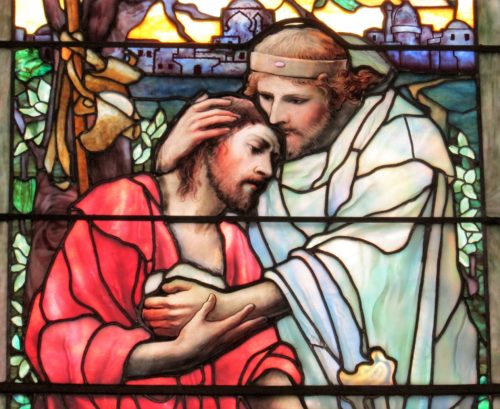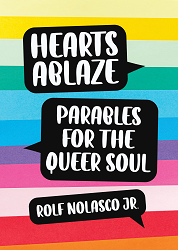Last Updated on January 9, 2024 by Kittredge Cherry

Lovingkindness from one man to another is celebrated in the Bible story of the Good Samaritan. Could one or both characters be LGBTQ?
The parable of the Good Samaritan will be read at many churches worldwide as the gospel reading for July 13, 2025 in the three-year lectionary cycle.

Good Samaritan window at Trinity Episcopal Church in Potsdam, NY. Photo by Kevin Elphick
The Good Samaritan story shows how all people are really neighbors, including strangers and outcasts such as LGBTQ people. It shows how compassion can come from people who are despised by society. Some queer interpretations of the Good Samaritan parable cast the traveler as an LGBTQ person who was bashed in a hate crime. Others identify the Samaritan as a queer who shocks conservatives by acting with compassion. Could both characters be gay?
The brotherly (possibly homoerotic) bond between the two men seems to be emphasized in a Tiffany stained-glass window at the historic Trinity Episcopal Church in Potsdam, New York.
The parable of the Good Samaritan (Luke 10:25-37) is one of the most beloved Bible stories. It begins when Jesus urges people to love their neighbors, and somebody asks, “Who is my neighbor?”
He responds by telling them about a traveler who was robbed, stripped, beaten and left half dead on the dangerous road from Jerusalem to Jericho. A priest and then a Levite (assistant to priests) passed by on the other side of the road to avoid the bleeding victim. The only one who stopped to help him was a Samaritan.
Most Jews looked down on Samaritans because they intermarried with Gentiles and therefore did not follow all the religious laws. Moved with compassion, this Samaritan tended the traveler’s wounds, carried him on his donkey to an inn and took care of him overnight. Then he paid the innkeeper to continue looking after the traveler. “Go and do likewise,” Jesus concluded.
The Trinity window shows the Samaritan embracing the wounded traveler with the Jerusalem skyline in the background. It was created around 1906 in memory of Rev. Reynold Marvin Kirby, rector at Trinity Episcopal from 1881 to 1906. It was made by the world-renowned Louis Comfort Tiffany Glass and Decorating Company.
LGBTQ visions of the Good Samaritan
 The Good Samaritan story is one of 10 parables of Jesus included in the forthcoming book “Hearts Ablaze: Parables for the Queer Soul” by Rolf Nolasco, theology professor at Garrett-Evangelical Theological Seminary in Evanston, Illinois. As Nolasco writes in the introduction, the book “recasts queer folk as Good Samaritans to those hurting—from individual relations to faith communities—out of the depths of pain we have endured both from the hands of robbers and religious communities.”
The Good Samaritan story is one of 10 parables of Jesus included in the forthcoming book “Hearts Ablaze: Parables for the Queer Soul” by Rolf Nolasco, theology professor at Garrett-Evangelical Theological Seminary in Evanston, Illinois. As Nolasco writes in the introduction, the book “recasts queer folk as Good Samaritans to those hurting—from individual relations to faith communities—out of the depths of pain we have endured both from the hands of robbers and religious communities.”
 Author Richard Cleaver draws a parallel between Samaritans and LGBTQ people because both groups are considered heretics who “chose a lifestyle” that reject traditional religious law. In the introduction to “Know My Name: A Gay Liberation Theology,” Cleaver analyzes the Good Samaritan parable and retells it as a modern gay man who rescues a man who was mugged and ignored by a bishop and a prominent lay leader.
Author Richard Cleaver draws a parallel between Samaritans and LGBTQ people because both groups are considered heretics who “chose a lifestyle” that reject traditional religious law. In the introduction to “Know My Name: A Gay Liberation Theology,” Cleaver analyzes the Good Samaritan parable and retells it as a modern gay man who rescues a man who was mugged and ignored by a bishop and a prominent lay leader.
Cleaver goes on to raise the question, “Could this parable, far from being a conventional tale about the importance of loving our neighbor, be telling us instead that it is to the oppressed, the heretic, the b— that we must go for teaching, rather than rest in the conventional pieties dispenses by the usual professionals?”
 John McNeill tells an updated version of the story in “Taking a Chance on God: Liberating Theology for Gays, Lesbians, and Their Lovers, Families, and Friends” (pp. 96–98). He describes how a how a priest and a social worker pass by a man who was mugged, but a transwoman “bound up his wounds with her best scarf” and calls a taxi to take him to the emergency room.
John McNeill tells an updated version of the story in “Taking a Chance on God: Liberating Theology for Gays, Lesbians, and Their Lovers, Families, and Friends” (pp. 96–98). He describes how a how a priest and a social worker pass by a man who was mugged, but a transwoman “bound up his wounds with her best scarf” and calls a taxi to take him to the emergency room.
McNeill goes on to warn: “There is, however, a danger that we as gay people, who have been falsely accused of the sin of Sodom, might at the very moment of our liberation become guilty of the real sin of Sodom: the sin of inhospitality and neglect of the poor.”
The inscription on Trinity’s stained-glass window strikes a similar chord. Lettering in the blue space at the bottom quotes what Jesus said in a different scripture: “Inasmuch as ye have done unto one of the least of these my brethren, ye have done it unto me.” (Matthew 25:40).
For the parable to convey its original meaning, the role of the Samaritan must be played by somebody who is expected to be heartless. The idea that an LGBTQ person can represent the Samaritan works well for a mainstream or evangelical congregation, but an LGBTQ congregation will get a better sense of the shocking substance of the story if a queer wounded traveler is ignored by LGBTQ folks and then rescued by a conservative from a hate group.
Queer poet explores the Good Samaritan
Queer poet Jim Wise finds surprising twists by exploring the love between the Good Samaritan and the Jew whom he rescued in his poem “The Samaritan.”
He describes himself as “Queer Poet, Hermetic Mendicant, and Pantheist, itinerant theologist and roving Chaote – an Earth-centered, Eros-loving, Logos-chasing, dirt-worshiping revolutionary – living in the American Midwest.” He considers himself “something of a UCC Old Catholic spiritual pilgrim” because he attended seminary under sponsorship of the United Church of Christ and was ordained in an Old Catholic jurisdiction. The following poem comes from his “Queer Psalter” collection, currently a work in progress. Wise’s poetry has appeared in RFD Journal, The Gay and Lesbian Review Worldwide, and a host of online literary journals and zines.
The Samaritan
By Jim Wise
At first I thought it
a piece of cargo fallen
from some passing caravan
but I got closer and
saw it was a man.
A Jew. The enemy.
He lay in fetal form
stripped bare, dried blood
caked into his beaten skin.
They had taken everything
but the tiny spark of life
still struggling to burn.
In the hot Judean sun
of that barren desert road,
we were the only two
people in the world.
A Samaritan and a Jew.
I was healthy and whole,
he was broken and beautiful,
and in that moment
I knew I needed him
as much as he needed me.
He was a stranger and I loved him.
Now, years later, I look into his face
and I know that I will always love him.
We saved each other that day
and one simple act of human decency
became a prayer to Heaven that
angry angels heard and so spared
the hateful world to live on
another day.
Links with LGBTQ views of the Good Samaritan
Parable of the Gay Samaritan (Quest: pastoral support for LGBT Catholics)
___
Image credit:
Good Samaritan window at Trinity Episcopal Church in Potsdam, New York. Photo by Kevin Elphick
This post is part of the LGBTQ Saints series by Kittredge Cherry. Traditional and alternative saints, people in the Bible, LGBT and queer martyrs, authors, theologians, religious leaders, artists, deities and other figures of special interest to lesbian, gay, bisexual and transgender and queer (LGBTQ) people and our allies are covered.
This article was originally published on Q Spirit in July 2019, was expanded with new material over time, and was most recently updated on July 15, 2023.
Copyright © Kittredge Cherry. All rights reserved.
Qspirit.net presents the Jesus in Love Blog on LGBTQ spirituality.







Hugging a wounded guy is not “homoerotic” unless you think the Samaritan is sexually turned on by a bleeding, battered fellow. The stained glass window just shows the idea of compassion in a manner which gets the point across despite the limited medium (a static image that cannot convey ideas very well without resorting to symbolism). And neither the Biblical text nor historical context has anything whatsoever to do with homosexuality (or any type of sexuality). The Samaritans belonged to a different ethnic group, descended from foreigners who migrated into Israel and converted to Judaism but retained some differences in practice (e.g. they refused to view Jerusalem as the most important holy site), hence the antagonism between them and Jews who were descended entirely from Hebrews. This has no possible connection to homosexuality.